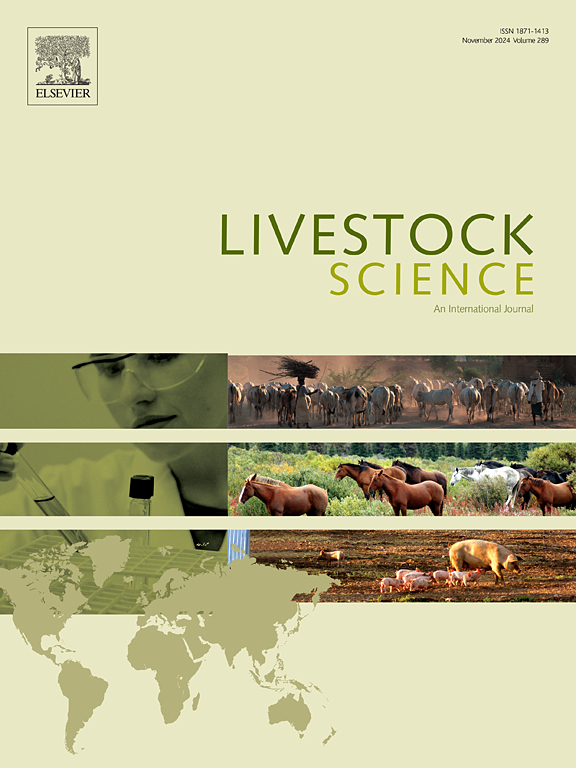Grazing intensity and associated frequency of human contact, and horn status, influence activity on pasture, physiological pre-slaughter reactions and meat quality in beef heifers
IF 1.8
3区 农林科学
Q2 AGRICULTURE, DAIRY & ANIMAL SCIENCE
引用次数: 0
Abstract
Meat quality is influenced by many factors related to the animal, such as its genetics and health status, farm management, and slaughter and processing conditions. The present study aimed to investigate the effects and interactions of grazing intensity and horn status on behaviour, physiological pre-slaughter stress status and meat characteristics of beef heifers. The study involved 32 horned and 32 disbudded F1 crossbred (Limousin ☓ Swiss Dairy breed) heifers during summer grazing on mountain pastures. Half of the heifers of each horn status were assigned to one of two grazing systems, balanced for live weight, dam and behavioural reactivity: grazing at either high (HI) or low (LI) grazing intensity. HI groups grazed in 3 times smaller paddocks and changed the paddock three times more often than LI groups. The effects of horn status and grazing intensity on physical activity on pasture, pre-slaughter stress and meat quality of the m. longissimus thoracis were studied. Compared to HI heifers, LI Heifers walked more when on pasture, showed greater stress levels before stunning, and their meat had greater water losses and greater early troponin levels. The varying pre-slaughter stress levels may be attributed to the differing frequency of human contact resulting from the differing frequency of paddock changes and may explain part of the effects on meat quality. Compared to disbudded heifers, horned heifers had faster heart rates at the abattoir, and their meat had lower cooking loss and was less juicy. Pre-slaughter heart rates showed robust correlations with various meat quality indicators. The study shows that both horn status and grazing management, including human contact, influence meat quality. Part of the effects may be related to different pre-slaughter physiological reactions, which subsequently influence meat quality.
放牧强度、与人接触的相关频率以及牛角状态影响肉用小母牛在牧场上的活动、宰前生理反应和肉质
肉质受许多动物相关因素的影响,如遗传和健康状况、农场管理以及屠宰和加工条件。本研究旨在调查放牧强度和牛角状态对肉用小母牛的行为、宰前生理应激状态和肉质特征的影响和相互作用。研究涉及 32 头有角和 32 头无角的 F1 杂交母牛(利木赞 ☓ 瑞士乳牛品种),它们夏季在山地牧场放牧。每种有角状态的母牛有一半被分配到两种放牧系统中的一种,这两种放牧系统在活重、母牛和行为反应性方面是平衡的:高强度放牧(HI)或低强度放牧(LI)。高放牧强度组放牧的围场比低放牧强度组小三倍,更换围场的次数比低放牧强度组多三倍。研究了牛角状态和放牧强度对牧草上的体力活动、宰前应激和胸长肌肉质的影响。与HI小母牛相比,LI小母牛在牧场上走得更多,在宰杀前表现出更大的应激水平,其肉的水分损失更大,早期肌钙蛋白水平更高。不同的宰前应激水平可能是由于更换围场的频率不同而导致与人接触的频率不同,这也可能是影响肉质的部分原因。与脱肛小母牛相比,有角小母牛在屠宰场的心率更快,肉的蒸煮损失更低,肉汁更少。屠宰前的心率与各种肉质指标有很强的相关性。研究表明,牛角状态和放牧管理(包括人与牛的接触)都会影响肉质。其中部分影响可能与屠宰前的不同生理反应有关,这些生理反应随后会影响肉质。
本文章由计算机程序翻译,如有差异,请以英文原文为准。
求助全文
约1分钟内获得全文
求助全文
来源期刊

Livestock Science
农林科学-奶制品与动物科学
CiteScore
4.30
自引率
5.60%
发文量
237
审稿时长
3 months
期刊介绍:
Livestock Science promotes the sound development of the livestock sector by publishing original, peer-reviewed research and review articles covering all aspects of this broad field. The journal welcomes submissions on the avant-garde areas of animal genetics, breeding, growth, reproduction, nutrition, physiology, and behaviour in addition to genetic resources, welfare, ethics, health, management and production systems. The high-quality content of this journal reflects the truly international nature of this broad area of research.
 求助内容:
求助内容: 应助结果提醒方式:
应助结果提醒方式:


